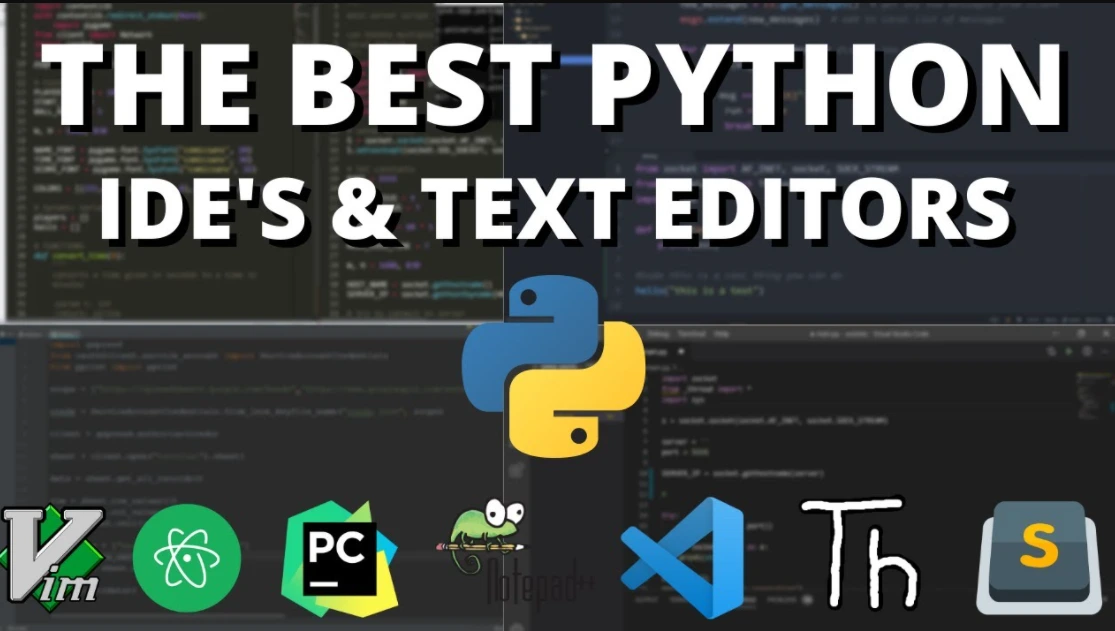Since launched in 1991, Python has evolved to be one of developers’ most used high-level programming languages. Despite being known for primarily high-end programs, it is also one of the most recommended programming languages for beginners that want to dive into the world of programming.
As common with any programming language, for you to code and start coding professionally, you’ll need dedicated software. Depending on your preference as a programmer, this software can either be an Integrated Development System (IDE) or a Code Editor.
This article will give a rundown of 10 of the best Python IDEs and Code Editor available in Windows, Mac, and Linux PCs. While most of the software on this list is Open Source (Free), a couple of others require payment before usage. Regardless of which you prefer to the other, from our tests, they all work great and contain the standard tools to write Python scripts.
Before we do just that, let’s take a look at the difference between an IDE and a Code Editor
Integrated Development Environment VS Code Editor
In simple terms, an IDE is a software package that contains all necessary tools for writing and testing a programming language (in this case, Python). An IDE typically automates some of the tasks, reducing the manual effort of the programmer.
An IDE generally consists of a source code editor used in writing the actual code for the program, local build automation for compilation, and a debugger for testing. Although most IDEs especially paid ones, may have more features integrated, these are the basics needed to be classified as an IDE program.
On the other hand, Code Editors can be seen as Text Editors with a little advancement in functionality. Developers use them to write codes. An example is Microsoft’s Visual Studio Code. Most developers who prefer Code editors do because it’s lightweight and saves small text files. Also, it allows programmers to edit multiple codes rather than IDEs which usually permit one programing language.
Now let’s highlight the best of these two software categories that Python Developers can use.
Best Python IDEs for Windows, Mac, and Linux
PyCharm
PyCharm, created by Jet Brains, is one of the best cross-platform Python IDEs you’ll find out there. It is often tipped as all a Python developer needs to be Productive because of its neat and simplistic layout. Part of the reason it takes the first position is that it’s integrated with APIs that allow developers to create their plugins, allowing them to improve on basic functionalities.
Price: $199 per year.
Notable Features:
- Intuitive Python Code Editor supports CoffeeScript, JavaScript, CSS, and TypeScript.
- Fast and Smart code navigation with efficient refactoring.
- Support for Python web development frameworks like JavaScript, MySQL, Oracle, Angular JS, etc.
- Integrated with IPython Notebook, Python console, and Scientific Stack.
Pros:
- Supports cross-platform development.
- The customizable interface increases productivity.
- Intuitive interface that supports auto code completion, error detection, etc.
Cons:
- Quite the pricey Python IDE when compared with other available options
- Relatively difficult to install
Eclipse (PyDev)
Coming up in 2nd position is Eclipse, an IDE originally designed for Java. However, with the application of plugins and extensions, it can be used to develop other programming languages like C, C++, PHP, and Python. Particularly, PyDev is the tool that enables Python development with this software.
Price: Open Source.
Notable Features:
- Handles certain automated tasks like code analysis and code completion.
- Features like debugger, code coverage, basic syntax highlighting, and Django are available.
- Integrated with several features like CPython, Jython, and IronPython.
Pros:
- Beginner-friendly interface.
- Supports smart and fast coding.
Cons:
- The layout is not overall captivating when compared with other options.
Spyder
Coming up on 3rd spot is Spyder, a software developed for and by scientists who work with Matplotlib, SciPy, NumPy, Pandas, and other Open Source programs. Made available through the Anaconda Open-Source distribution system, Spyder is one of the best IDEs with advanced-level edit and debug capabilities.
Price: Open Source.
Notable Features:
- Integrated with PYQT functionality, making it easily extensible
- Multi-language editing capability.
- Syntax highlighting, auto code completion, and code analysis functionality.
Pros:
- Can run Python code by cell, line, or file in Windows PC.
- Great support feature, making it beginner-friendly.
Cons:
- Having too many plugins will ultimately reduce its performance.
- Developers can’t select which warnings should be disabled while coding.
Integrated Development and Learning Environment (IDLE)
Up next is IDLE, the default IDE for Python. To date, it remains one of the best Python editors there. It is quite the simple IDE, best for beginners who want a smooth and basic approach to learning Python. However, most Python programmers consider it the sacrificeable IDE because beginners often migrate to other advanced IDEs after getting the basics.
Price: Open Source.
Notable Features:
- Support for dialog boxes, bowsers, and editable configurations.
- Multi-window text editing with additional features like call tips, undo, and colorizing.
- Syntax highlighting, auto code completion, debugger, and smart indentation capabilities.
Pros:
- Allows search for multiple files.
- Presence of a Python shell with a highlighter.
- Allows execution of single statement programs.
Cons:
- Absence of numbered lines in the coding interface.
- Requires a respective package manager for installation.
Eric Python
Developed by Detlev Offenbach for Python, Eric is another feature-rich Python IDEs available across platforms. It’s designed to satisfy the needs of amateur Python programmers and professional developers. Being developed on QT Toolkit, it uses the flexible Scintilla editor.
Price: Open Source.
Notable Features:
- Usage of multiple editors and customizable window layout.
- Integrated with the debugger, task manager, profiler, and code coverage.
- Error highlighting and advanced search options.
Pros:
- Supports unittest, COBRA, and google protobuf.
- Integrated with rope refactoring tool
Cons:
- Installation is often difficult
- Complicated GUI
Best Code Editors for Windows, Mac, and Linux
Sublime Text
Developed in C++, Sublime Text is one of the most popular text editors among programmers. Much of the reason is that it’s capable of handling other languages, not just Python alone. Based on reviews by Python developers, it’s arguably the most reliable option to pick from other code editors.
Price: $99 for the full license.
Notable Features:
- Command palette implementation.
- Customizable interface.
- Integrated with split editing, word or symbol search, and instant project switch functionality.
Pros:
- Compatible with language grammars.
- Fast execution, with fewer bugs.
- Can work with large files.
Cons:
- It can be challenging to use, especially for beginners.
- Pricey when compared with other options.
Atom
Often confused by beginners to be an IDE, Atom is a source code editor with the basic features present in IDEs. It is works based on atom shells, which are the framework for obtaining cross-platform functionality. Atoms can also be packed with enough Plugins and features to be classified as an IDE.
Price: Open Source.
Notable Features:
- In-built package manager and file browser.
- Smart auto-completion in scriptwriting.
Pros:
- Easy to use
- Customizable user interface.
Cons:
- Doesn’t perform optimally when handling large codes.
- Consumes significantly more RAM when compared with other options.
Vim
Since first published in 1991, Vim has become one of the most widely used text editors for programming. Credits to consistent improvements by the developer, and the developer community, Vim is tipped to be the most stable and performance efficient text editor in the programming space. It has integrated three modes; the insert mode, normal or command mode, and command-line mode.
Pricing: Open Source.
Notable Features:
- Provides multiple modes to work with.
- Integrated with extensive system plugins.
- Multilevel undo tree.
- Smart search and replace tool.
Pros:
- Fully customizable interface.
- Recognition and conversion of file formats across platforms.
Cons:
- It can be challenging to learn at first introduction to the software.
- Does not support smart editing.
GNU/Emacs
Emacs, one of the oldest text editors known in the developer community, comes up in 9th place. The software developed by Richard Stallman is a free customizable text editor without restrictions. GNU Emacs implements an extension language called Emacs Lisp, enabling it to handle tasks like writing, compiling programs, reading emails, etc. For Python development, the extension Elpy is used.
Price: Free
Notable Features:
- Syntax highlighting and automatic indentation.
- Extensible functionality with plugins
Pros:
- Customizable user interface
- Smart maintenance of text structure by automatic insertion of elements
Cons:
- It has a steep learning curve
Visual Studio Code
Developed by Microsoft and licensed by MIT as open-source, VS Code is a great text editor with many functionalities. Just like Atom, it can be easily confused to be an IDE because of the extensive features available with plugins. Although VS Code was published just in 2015, it has received a lot of contributions from the developer community and currently has over 4700 extensions.
Price: Free
Notable Features:
- Smart debugger and in-editor debugging
- Supports auto code completion, syntax highlighting, etc.
Pros:
- Customizable user interface
- Assortment of Plugins to help with coding
- Simplistic layout
Cons:
- Slow launch time
- Very slow when doing searches



